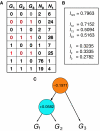Computational analysis of the synergy among multiple interacting genes
- PMID: 17299419
- PMCID: PMC1828751
- DOI: 10.1038/msb4100124
Computational analysis of the synergy among multiple interacting genes
Abstract
Diseases such as cancer are often related to collaborative effects involving interactions of multiple genes within complex pathways, or to combinations of multiple SNPs. To understand the structure of such mechanisms, it is helpful to analyze genes in terms of the purely cooperative, as opposed to independent, nature of their contributions towards a phenotype. Here, we present an information-theoretic analysis that provides a quantitative measure of the multivariate synergy and decomposes sets of genes into submodules each of which contains synergistically interacting genes. When the resulting computational tools are used for the analysis of gene expression or SNP data, this systems-based methodology provides insight into the biological mechanisms responsible for disease.
Figures



References
-
- Boser BE, Guyon IM, Vapnik VN (1992) A training algorithm for optimal margin classifiers. In 5th Annual ACM Workshop on COLT, Haussler D (ed), pp 144–152. Pittsburgh, PA, USA: ACM Press
-
- Brenner N, Strong S, Koberle R, Bialek W, de Ruyter van Steveninck R (2000) Synergy in a neural code. Neural Comput 12: 1531–1552 - PubMed
-
- Chechik G, Globerson A, Anderson M, Young E, Nelken I, Tishby N (2002) Group redundancy measures reveal redundancy reduction in the auditory pathway. In Advances in Neural Information Processing Systems, Dietterich TG, Becker S, Ghahramani Z (eds), pp 173–180. Cambridge, MA: MIT Press
-
- Cover T, Thomas J (2006) Elements of Information Theory. New York, NY, USA: Wiley Interscience
MeSH terms
LinkOut - more resources
Full Text Sources
Other Literature Sources

